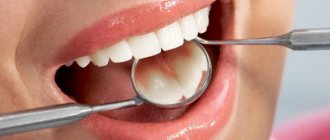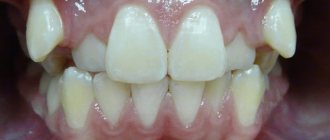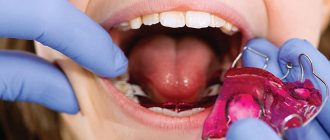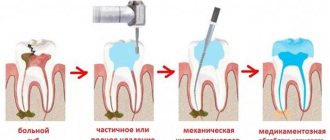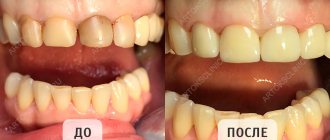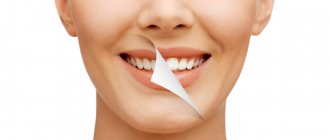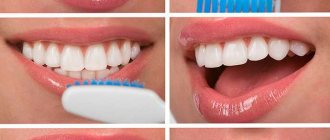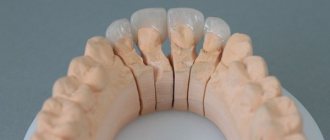Natural color is milky white, slightly translucent. If the teeth are snow-white, the dentist has intervened; such tones are not present from birth. The shade depends on dentin and enamel. In a person's youth, the enamel layer is stronger. The dentition looks whiter if the enamel layer is dense and does not allow light to pass through. This is achieved by removing irregularities.
With age, teeth wear down, the surface becomes smoother, light passes through more easily, which makes the image dimmer. The enamel becomes brown, yellow, black or gray. Different parts of the structure have different colors. A light shade predominates on top, a dark shade on the bottom. But each person has his own natural tone - this is normal.
Author of the article: Shirokov Ivan Yurievich
Work experience:
15 years
Specialization:
Dentist-orthopedist
Works:
at the clinic on Butyrskaya metro station
Metal-ceramic teeth. How has the material proven itself?
Metal-ceramic dentures are a crown or bridge on a metal frame coated with ceramic. The orthodontic design is identical to the shape of a real tooth, so the prosthesis is easily installed in the jaw and does not cause discomfort to the patient while wearing it. According to statistics, metal-ceramic implants are much less likely than other prostheses to cause an allergic reaction. Most often, specialists at the A-Medic clinic use ceramic prostheses to restore teeth in the chewing region. The material has proven itself optimally not only from an aesthetic, but also from a practical point of view. The main advantages of metal-ceramic prostheses are:
- reliability;
- functionality;
- aesthetic indicators;
- ease of installation;
- affordable price for most patients.
Thanks to the unique properties of ceramics, the dentist has the opportunity to select a prosthesis whose shade best matches the color of the client’s own teeth. Provided that it is installed properly, a ceramic-coated implant is invisible in the mouth and therefore does not cause psychological discomfort to a person.
Vita scale
First of all, veneers are installed on teeth that are located in the smile area. Color veneering is used to correct congenital and acquired aesthetic defects.
The Vita scale is a tooth shade table divided into 4 classes:
- A – red-brown;
- B – red-yellow;
- C – gray shades;
- D – spectrum of red-gray shades.
Each class has a palette of shades arranged sequentially. For example, the first number denotes the most saturated, and the fourth number the least saturated.
Using a tint scale, a specialist selects a color based on two indicators:
- Class;
- shade for each individual veneer.
The palette includes 16 tones, allowing you to perform prosthetics using preliminary visualization. First of all, the doctor evaluates the initial color of the enamel, then brings templates to it one by one.
Reference! The scale is made of high density laminated paper and plastic. The most advantageous option is a table with ceramic templates or retractable acrylic plates. In practice, the whitest color is rarely used.
Metal-ceramic dental prosthetics
The technology has proven itself most actively in the restoration of chewing teeth, where not only aesthetics, but also strength are important. The widest range of ceramic coatings for dentures allows the material to imitate the structure of human dental tissue as accurately as possible.
Inexpensive metal-ceramics are used a little less frequently for the correction of front teeth, because the metal frame can be seen through the thin ceramic coating. That is why, for prosthetic treatment of front teeth, A-Medic dentists recommend that patients opt for ceramics based on zirconium. Essentially, this is the same metal-ceramics, which is based on white metal. Zirconium metal ceramics can be installed on any patient, even those prone to allergies, because the material is 100% biocompatible with the human body.
What color of veneers should I choose?
A doctor will help you find the right shade for your restorations, ideally together with a dental technician.
If it is necessary to restore the aesthetics of individual teeth, the color of the onlays is selected in accordance with the shade of the “neighbors”. Before getting veneers, you may be recommended a whitening procedure to make your teeth 1-2 shades whiter and choose lighter veneers. Using a palette, the doctor determines the color of each restoration separately, since the central incisors, lateral incisors and canines naturally have different colors and degrees of brightness.
If we are talking about installing veneers on all teeth, then certain rules apply for choosing a shade.
Dental metal ceramics. What does the crown look like?
Metal-ceramic dental prostheses have a simple design. This is a metal frame, coated with hypoallergenic ceramic. Compared to previous composite prostheses, this design has a number of significant advantages:
- the material reproduces well the color and texture of natural teeth;
- ceramics do not absorb food dyes and do not fade over the years;
- the product is hypoallergenic, therefore it does not cause side effects in the first days after installation;
- The prosthesis turns out to be very strong, capable of withstanding heavy loads that are applied to the chewing teeth every day.
Dentistry "A-Medic" offers patients removable and non-removable ceramic dentures. The installation of a removable orthodontic structure is justified if the patient has a number of contraindications to the installation of permanent metal or ceramic dentures. The dentist will help identify the presence of such contraindications after a visual examination of the patient’s oral cavity and study of the general history.
Nature or whiteness
Everyone knows: if you want to correct the shade, shape and size of your teeth, get veneering, which will help you look ten years younger.
How does this happen? As we age, the skin, body and bone organs of the mouth undergo aging. Teeth wear down and their appearance changes for the worse. They become short in length, which disrupts the paths of the canines and incisors. The facial muscles begin to work incorrectly, reducing chewing efficiency.
To protect the patient from the formation of facial and statistical folds, wrinkles in the nasolabial area, and to ensure a beautiful smile line, specialists add height and volume to the elements of the dentition if they are deficient.
Much attention is paid to nature and whiteness. All of these factors have a positive effect on appearance: the patient looks younger than his age.
Many patients with naturally soft tooth enamel want to whiten them several shades with the help of veneering so that their smile will be snow-white, like a movie star.
Experts do not recommend overdoing it, because excessive whiteness can not decorate, but ruin the overall appearance. Best the enemy of the good.
If you look deeply into this issue, the beauty of a smile is characterized by several parameters:
- the color of each element of the dentition;
- the location of each unit in the dental arch;
- the shape of all elements.
It is clear that a snow-white tooth with a clean surface, standing exactly in its place in a row, without defects, has a more attractive appearance in comparison with an uneven unit, yellowed from bacterial colonization.
In the absence of pronounced flaws, the color of the bone organs of the oral cavity is much more important, since it catches the eye of others more quickly. And, as you know, by the condition of the teeth, others determine a person’s trustworthiness, neatness, presentability, state of health, and physical capabilities.
But deliberate snow-white teeth will not add attractiveness, because it creates a feeling of insincerity, pretense, deception, something artificial, unreal.
For this reason, patients are increasingly puzzled by the issue of unnatural looking teeth after veneering.
Remarkable! In recent years, snow-white teeth are rapidly going out of fashion. A dazzling white smile cannot be found in nature and cannot be achieved through careful hygiene. The trend is an emphasis on natural color - the pristine whiteness of teeth, given to a person since childhood.
In the dental industry this problem can be solved today. To make it easier to accurately select the color that best matches the shade of the protective layer of the patient’s teeth, doctors have developed a special color scale.
This special table of tooth color perception in alphanumeric format greatly simplifies the work of the dentist when installing veneers.
Recommendations for caring for veneers to extend their service life.
Come here to take a closer look at Snap on smile veneers.
At this address https://www.vash-dentist.ru/protezirovanie/nesemnyie-p/viniryi-np/chto-takoe-polevoshpatnyie.html we will talk about the features of making feldspathic veneers.
Dentistry. Metal-ceramic prosthetics: pros and cons
Having decided to visit the dentist to restore the integrity of the dentition, many patients are interested in the question of whether metal-ceramic dental prosthetics can harm their health or not. A-Medic specialists claim that if the production of metal ceramics is carried out from high-quality certified materials in a professional laboratory, then the risk of complications after prosthetics is minimized.
The dentures are entirely made of non-toxic materials. Individual side effects and complications after implantation in the jaw are caused, to a greater extent, by the characteristics of the body and oral cavity of a particular patient.
The reasons why most patients choose a combination of metal and ceramics are:
- cost of metal-ceramic prosthetics;
- strength;
- lifetime;
- aesthetic indicators.
The disadvantage of this technology for restoring the integrity of the dentition is the need for deeper treatment of the living tissues of the adjacent tooth. However, if the dentist is properly experienced and the work is done carefully, this side effect will wear off.
What is zirconium dioxide?
When creating dental prostheses, metals are used, since one of the indicators of the quality of crowns is their reliability and resistance to stress, but not in their pure form. So many dentists recommend zirconium crowns. However, to create prostheses, it is not pure metal that is used, but zirconium dioxide, which is a material of increased strength.
Increasingly, in implantology, despite the high price, zirconium crowns are used. What is their advantage over other materials for prostheses? First of all, it is durability and color. In orthopedics, zirconium dioxide is called “white gold”. Its color is as close as possible to the natural shade of the teeth, which allows you to achieve greater naturalness after prosthetics. If the installation process is carried out in accordance with all requirements, the structure can last up to 20 years.
Since dentures made of zirconium have an impeccable appearance, they are often used in the reconstruction of anterior teeth. The material has a certain degree of transparency, thanks to which it easily adapts to the natural shade of the enamel, thus, does not stand out among the entire dentition.
Metal ceramics are inexpensive. How are dentures installed?
Installation of ceramic dentures occurs in several stages. First, the patient needs to make an appointment with the selected dentist, undergo diagnostics and dental treatment, if necessary. Also, a mandatory stage of prosthetics is a general diagnosis of the body and a study of the patient’s medical history at the time of identifying contraindications. The dentist then follows the following therapeutic plan:
- preparation of teeth for a crown (grinding down enamel, removing nerves);
- taking impressions from the received supports, according to which an individual orthodontic design will be made in the future;
- fitting of prostheses, their polishing and correction:
- installation of the structure.
On average, dental prosthetics with metal-ceramics at the A-Medic clinic takes about two weeks. Dentists draw the attention of patients to the fact that when choosing a ceramic design, a more gentle grinding of tooth enamel from the supporting tooth is performed. This is possible due to the small thickness of the ceramic coating. Metal-ceramic dental prosthetics does not require complete grinding of bone tissue, so the risk of irritation, swelling and allergies after inserting the prosthesis into the oral cavity is minimal.
Optimal enamel color and reasons for its change
It is a mistake to assume that only white teeth are a sure sign of good health. Moreover, even enamel that has turned yellow over time should not be taken as a serious cause for concern, remembering that, in addition to dental problems, such changes are provoked by many other factors.
According to research data, 97 percent of enamel has nothing to do with organic compounds, which means that it will be extremely difficult to choose an identical shade of teeth for two different people, it’s all so individual.
Why does the whiteness of teeth depend and what factors tend to influence its change? The most common of them are:
- hereditary predisposition and tendency to all kinds of dental diseases;
- failure to comply with personal hygiene rules or improper brushing of teeth;
- eating foods and drinks that contain various groups of dyes (berries, coffee, soy sauce, etc.);
- smoking;
- age-related changes with which dentin begins to darken, acquiring a red-brown tone;
- degree of strength of dental bone tissue;
- excess or deficiency of certain vitamins in the body;
- the thickness of the enamel layer through which dentin, which is naturally yellow in color, can be visible;
- microrelief of teeth, the severity of which determines whiteness.
In order to preserve pristine whiteness, a person will have to apply maximum effort to this from childhood, which is not always convenient. And it’s not a fact that they will give an effective result, because it’s not without reason that only a few can boast of the ideal color of their teeth, most often owing their beauty to nature.
It is difficult to single out the most popular shade, because the enamel color of each person is unique. The scale only helps you choose the most suitable color. One thing is for sure - now natural color is in fashion, not perfectly snow-white
Metal ceramics prosthetics. Features of caring for orodontic structures
There are no super complex rules for caring for ceramic teeth. Dentists recommend that patients undergoing prosthetics adhere to standard hygiene standards. When cleaning your mouth, you need to follow these simple rules:
- Brushing your teeth twice a day and rinsing your mouth after every meal.
- No special hygiene products or brushes are required; standard accessories will do.
- The movements of the brush should be sweeping, directed from the edge of the gums to the edge of the tooth.
- Dental floss is allowed.
To avoid the development of symptoms of secondary caries, experts advise not to forget about regular visits to the dentist. This will help eliminate destructive processes under the crown at the stage of their inception. If necessary, the dentist can perform crown restoration directly in the patient's mouth. This is necessary if the prosthesis has chipped or cracked. Such situations are extremely rare, but they also occur when the orodontic structure is used carelessly. Restoration with composite materials is only possible if the metal frame is not completely exposed, otherwise a complete replacement of the crown will be required.
Metal-ceramic teeth: prices for the service
Metal-ceramic prosthetics prices depend on many factors. In any case, such a crown is cheaper than one made from solid ceramics or with a zirconium base. The cost of a metal-ceramic tooth is determined precisely by the material used to make the structure. Dentists note that prosthetics with metal and ceramic crowns are considered the most budget-friendly option, while the quality and aesthetic properties of the prosthesis are no worse than those of other models.
Metal-ceramics installation cost at the A-Medic clinic includes:
- primary treatment of the tooth surface for a crown (dental treatment, if necessary, is paid separately);
- taking and making impressions;
- production of a permanent crown in the clinic laboratory;
- implantation by an orthopedist.
During your initial visit to a specialist’s office, the dentist will necessarily draw up a financial treatment plan. The patient will be offered several options to restore the aesthetics and function of the teeth. Metal-ceramics price allows you to perform effective oral treatment that does not go beyond the budget planned by the clinic client for treatment. You can make an appointment with an orthodontist by phone or on the clinic’s website at a time convenient for the patient. Consultations are provided free of charge.
